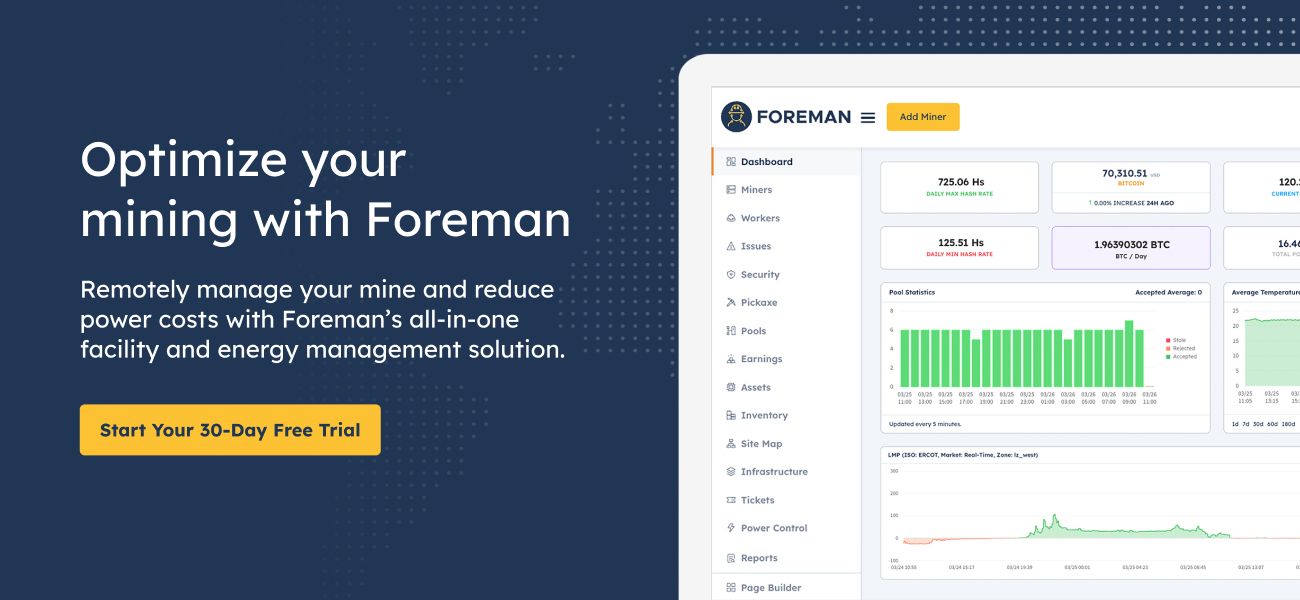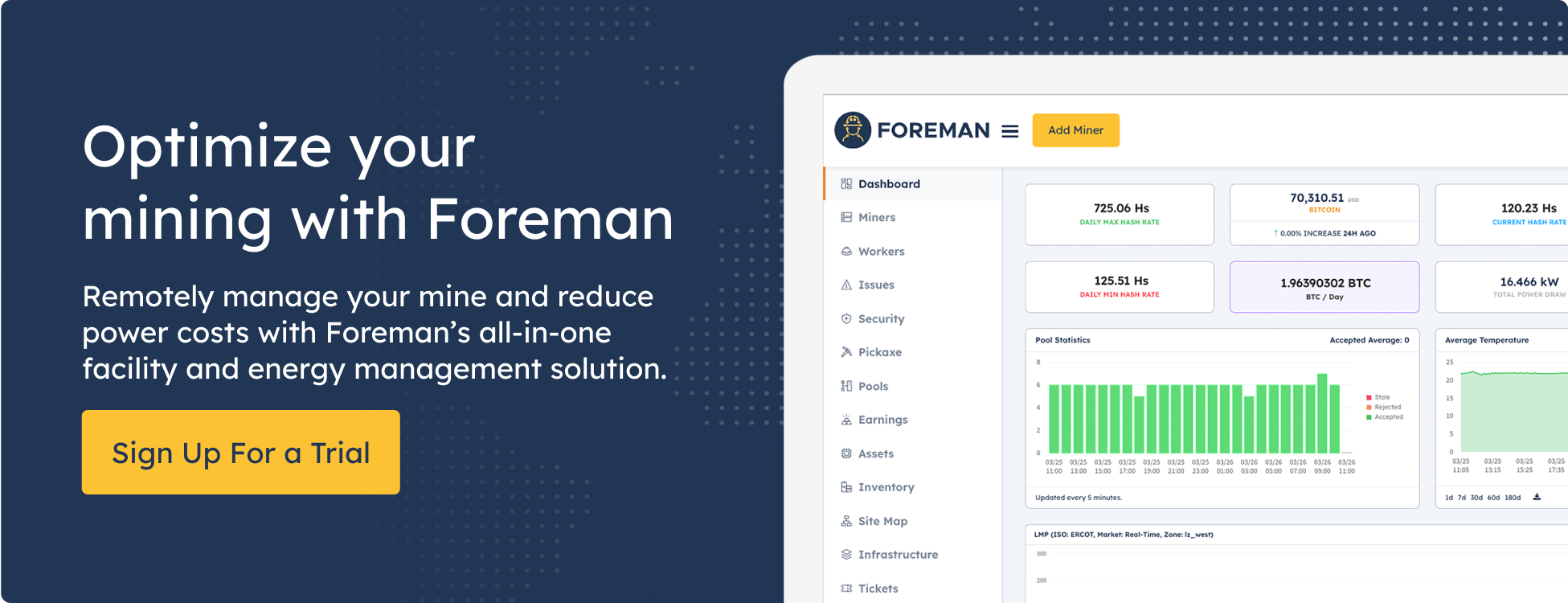With today’s competitive Bitcoin mining environment, it is critical to be precise with all equipment used in the facility. Mining facilities house thousands of ASICs that require reliable and efficient power distribution to operate optimally.
A smart PDU (Power Distribution Unit) is a modern solution that offers advanced power management and monitoring features to help businesses improve energy efficiency, reduce costs, and increase uptime. This article will explore the differences between basic PDUs, the benefits of using smart PDUs, and how they can optimize power usage, improve reliability, and enhance overall performance by integrating the Foreman platform.
Overview Of PDUs
A PDU (Power Distribution Unit) is essential to distribute power to multiple electronic devices from a single power source. These devices are critical components in mining facilities, data centers, server rooms, and other technology-intensive environments where reliable and efficient power distribution is essential for business operations.
Basic PDUs
Generic PDUs are a simple solution to distribute power to multiple devices from a single power source while providing several critical functions, including power distribution, circuit protection, cable management, and mounting options.
The core function of a basic PDU is to provide a means to distribute power to multiple devices. The function is achieved through multiple outlets or sockets available in the PDU that allows multiple devices to connect to a single power source. Basic PDUs reduce the wiring required and simplify powering multiple devices. They are glorified extension cords for high-powered devices. Circuit protection is a critical function of a basic PDU as it protects the connected devices from power-related issues such as surges, overloads, and short circuits.
Cable management is another essential function of a basic PDU, as it helps to keep the installation neat, making it easier to access and maintain the devices. A well-organized installation also ensures that power cords are not tangled or damaged, reducing the risk of fire hazards or electrical accidents. Mounting options available in a basic PDU provide flexibility in how the PDU is installed, allowing it to be positioned in the most convenient location for the devices it is powering. Rack-mount, wall-mount, or floor-mount options suit different installation needs.
Smart PDUs
Smart PDUs are the most advanced and offer features like remote monitoring, individual outlet control, energy metering, and environmental sensors, providing advanced power management and monitoring capabilities. Below is a list of the key features and use cases of smart PDUs.
What Are The Key Features Of Smart PDUs?
Smart PDUs, or Power Distribution Units, are pivotal components within data centers and similar environments where efficient power management is essential. These devices are equipped with various features geared towards optimizing power distribution, enhancing energy efficiency, and ensuring the availability of critical equipment. Below are some standard key features:
Remote Power Monitoring: Provides real-time power usage monitoring, offering information on voltage, current, and power consumption at the outlet and device level.
Power Consumption Tracking: Tracks energy consumption over time, aiding in identifying usage trends and patterns for better energy management.
Outlet-Level Metering: Measures power consumption at the individual outlet level, facilitating the identification of devices or equipment using excessive power.
Remote Power Cycling: Allows IT administrators to remotely turn individual outlets on or off, helping to conserve power when devices are not in use and aiding in troubleshooting.
Environmental Monitoring: Often includes sensors for temperature, humidity, and airflow, enabling the detection of areas where cooling is inefficient and energy is wasted.
Alerts and Notifications: Sends alerts or notifications when power usage or environmental conditions surpass predefined thresholds, enabling quick responses to prevent issues from escalating.
Network Connectivity: Typically includes network connectivity, facilitating remote management, and monitoring through a web interface or other networked management systems.
Phase Balancing: Ensures even electrical load distribution across phases in three-phase power distribution systems, minimizing the risk of overloading on any single phase.
Energy Cost Management: Calculates energy costs based on power consumption data, assisting organizations in budget allocation and energy-saving strategies.
Redundancy and Failover: Equipped with redundant power supplies and failover capabilities, ensuring uninterrupted power distribution even during PDU or power source failures.
Security Features: Includes security measures such as password protection, user authentication, and encryption to safeguard against unauthorized access and control.
Integration with Management Systems: Designed for seamless integration with data center management systems like DCIM software, streamlining monitoring and control across the entire data center ecosystem.
Scalability: Available in various configurations and form factors to accommodate power distribution needs, making them suitable for environments of different sizes.
Foreman is a comprehensive systems management tool that integrates with Smart PDUs to map containers or sites precisely based on plug location. One of the key features of a smart PDU is remote management, which allows Foreman to monitor and control the PDU from a remote location using the platform. This enables administrators to easily access information about the power usage of individual outlets and devices, set up automated site map locations, and remotely turn on or off individual outlets through power cycling. To understand how to set up the site map function using a smart PDU, check out our post here.
Another advanced feature of a smart PDU is power monitoring. Smart PDUs can measure and report power usage at the individual outlet level, providing Foreman with detailed information about the power consumption of each device. This data can be used for capacity planning, troubleshooting, and energy efficiency optimization. With the help of power monitoring, Foreman can identify which devices are consuming the most power and take steps to optimize energy usage, reduce costs, and improve overall efficiency.
Outlet control is another feature that sets smart PDUs apart from basic PDUs. Smart PDUs offer individual outlet control, which allows Foreman to remotely turn on or off individual outlets or set up automated power schedules that are useful in Demand Response. Individual outlet control enables Foreman to manage power usage more efficiently and ensure uptime while precisely targeting miners through phases of Demand Response curtailments.
With smart PDUs, Foreman utilizes miners to cycle up and down miners. However, future use cases could utilize anything plugged into the PDU, including large facility fans.
Choosing A PDU
When selecting a PDU, it is important to consider your specific power distribution needs and the features that will be most useful in your environment. A basic PDU may be sufficient if you have a relatively simple setup with a limited number of devices. However, suppose you require more advanced power management features such as remote monitoring and control, power monitoring, environmental monitoring, and individual outlet control. In that case, a smart PDU may be the better option.
Factors such as mounting options, power capacity, and compatibility with your existing hardware should also be considered. By carefully assessing your needs and evaluating the available integration options, you can select a PDU that provides the right features and functionality for your specific requirements.
Related Articles:
- ASIC Container Mining 101 (Prices, Cooling, Deployment + more)
- How do I add and associate APDUs using the Infrastructure feature?



